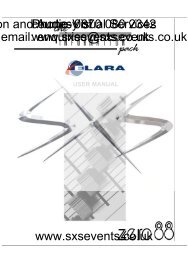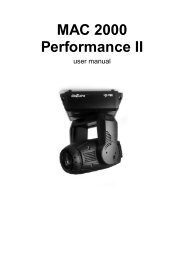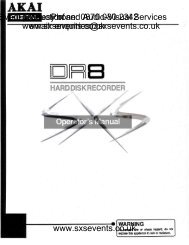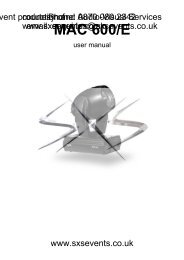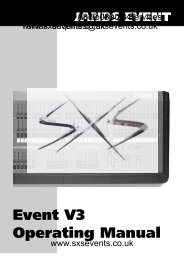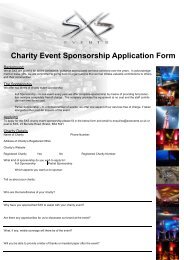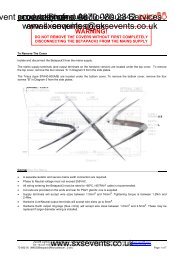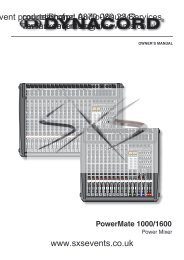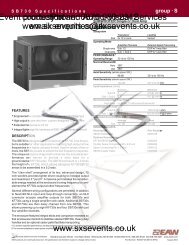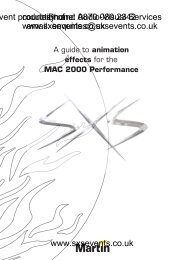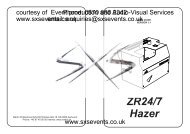Rigging - CM Lodestar Manual - SXS Events
Rigging - CM Lodestar Manual - SXS Events
Rigging - CM Lodestar Manual - SXS Events
You also want an ePaper? Increase the reach of your titles
YUMPU automatically turns print PDFs into web optimized ePapers that Google loves.
vent courtesy production V! Phone: WARNING of and 0870 Audio-Visual 080 2342Services<br />
9. On single reeved chain hoist used in conjuction with head<br />
blocks and ground support systems. Check for twists<br />
between the hoist and head block. Twisted load can result<br />
in a jammed liftwheel.<br />
10.Do not allow the load to bear against the hook latch. The<br />
latch is to help maintain the hook in position while the<br />
chain is slack before taking up slack chain.<br />
11. Take up a slack load chain carefully and start load easily to<br />
avoid shock and jerking of hoist load chain. If there is any<br />
evidence of overloading, immediately lower the load and<br />
remove the excess load.<br />
12.Do not allow the load to swing or twist while hoisting.<br />
13.Never operate the hoist when flammable materials or<br />
vapors are present. Electrical devices produce arcs or<br />
sparks that can cause a fire or explosion.<br />
14.STAY ALERT! Watch what you are doing and use<br />
common sense. Do not use the hoist when you are tired,<br />
distracted or under the influence of drugs, alcohol or<br />
medication causing diminished control.<br />
Periodic Inspections: These inspections are visual inspections<br />
of external conditions by an appointed person. Records of<br />
periodic inspections are to be kept for continuing evaluation of<br />
the condition of the hoist.<br />
Allowing the load to bear against the hook latch and/or hook<br />
www.sxsevents.co.uk<br />
email: enquiries@sxsevents.co.uk<br />
tip can result in loss of load.<br />
Periodic inspections are to be performed yearly for normal<br />
TO AVOID INJURY:<br />
service, semi-annually for heavy service and quarterly for<br />
Do not allow the load and/or attachments to bear against<br />
severe service, and they are to include those items listed in<br />
the hook latch and/or hook tip. Apply load to hook bowl or<br />
Table 5.<br />
saddle only.<br />
CAUTION: Any deficiencies are to be corrected before<br />
the hoist is returned to service. Also, the external conditions<br />
may show the need for disassembly to permit a<br />
more detailed inspection, which, in turn, may require the<br />
use of nondestructive type testing.<br />
PREVENTIVE MAINTENANCE<br />
In addition to the above inspection procedure, a preventive<br />
maintenance program should be established to prolong the<br />
useful life of the hoist and maintain its reliability and continued<br />
safe use. The program should include the periodic and frequent<br />
inspections with particular attention being paid to the lubrication<br />
of the various components using the recommended<br />
lubricants (see page 11).<br />
HOOK INSPECTION<br />
Hooks damaged from chemicals, deformations or cracks, or<br />
that have more than a 10 o twist from the hook’s unbent plane,<br />
excessive opening or seat wear must be replaced. Also, hooks<br />
that are opened and allow the latch to not engage the tip must<br />
be replaced. Any hook that is twisted or has excessive throat<br />
opening indicates abuse or overloading of the unit. Inspect<br />
other load sustaining parts, hook block screws, load pins and<br />
hook block bodies for damage.<br />
INSPECTION<br />
To maintain continuous and satisfactory operation, a regular<br />
inspection procedure must be initiated to replace worn or<br />
damaged parts before they become unsafe. Inspection intervals<br />
must be determined by the individual application and are<br />
based on the type of service to which the hoist will be subjected<br />
and the degree of exposure to wear, deterioration or malfunction<br />
of the critical components.<br />
On latch type hooks, check to make sure that the latch is not<br />
damaged or bent and that it operates properly with sufficient<br />
spring pressure to keep the latch tightly against the tip of the<br />
hook and allow the latch to spring back to the tip when<br />
released. If the latch does not operate properly, it should be<br />
replaced. See Figure 14 to determine when the hook must be<br />
replaced.<br />
The type of service to which the hoist is subjected can be classified<br />
as “Normal”, Heavy”, or “Severe”.<br />
Normal Service: Involves operation with randomly distributed<br />
loads within the rated load limit, or uniform loads less than 65<br />
percent of rated load for not more than 25 percent of the time.<br />
Heavy Service: Involves operating the hoist within the rated<br />
load limit which exceeds normal service.<br />
Severe Service: Normal or heavy service with abnormal<br />
operating conditions.<br />
Two classes of inspection - frequent and periodic - must be<br />
performed.<br />
Frequent Inspections: These inspections are visual examinations<br />
by the operator or other designated personnel.<br />
Records of such inspections are not required. The frequent<br />
inspections are to be performed monthly for normal service,<br />
weekly to monthly for heavy service, and daily to weekly for<br />
severe service, and they should include those items listed in<br />
Table 4.<br />
www.sxsevents.co.uk<br />
8



